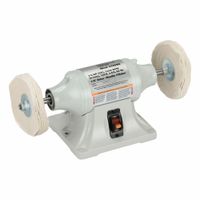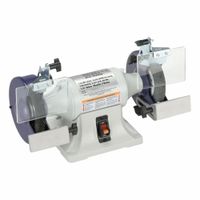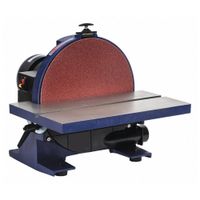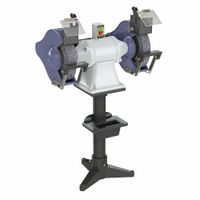Call +(254) 703 030 000 / 751 483 999 / 721 704 777
.....Read More
Frequently Asked Questions
What is the difference between a bench grinder and a pedestal grinder?
A bench grinder and a pedestal grinder are both types of grinding machines used for sharpening, shaping, and polishing metal and other materials, but they differ primarily in their design and application.
A bench grinder is a compact, versatile tool typically mounted on a workbench. It consists of a motor with two grinding wheels on either side. Bench grinders are commonly used for small-scale tasks such as sharpening tools, deburring, and shaping small metal parts. They are ideal for home workshops or small-scale operations due to their portability and ease of use. Bench grinders often come with adjustable tool rests and eye shields for safety.
In contrast, a pedestal grinder is a larger, more robust machine designed for heavy-duty industrial applications. It is mounted on a pedestal or stand, which raises the grinder to a convenient working height. Pedestal grinders are used for larger-scale grinding tasks and can handle more substantial workpieces. They are commonly found in manufacturing facilities, metalworking shops, and other industrial environments. The pedestal design provides stability and allows for the use of larger, more powerful motors, making them suitable for continuous, high-volume grinding operations.
In summary, the main differences between a bench grinder and a pedestal grinder lie in their size, mounting, and intended use. Bench grinders are smaller, portable, and suitable for lighter tasks, while pedestal grinders are larger, stationary, and designed for heavy-duty industrial applications.
How do I choose the right abrasive wheel for my grinding machine?
To choose the right abrasive wheel for your grinding machine, consider the following factors:
1. **Material Type**: Identify the material you are grinding. Different materials require different abrasives. For example, aluminum oxide is suitable for ferrous metals, while silicon carbide is better for non-ferrous metals and non-metallic materials.
2. **Wheel Type**: Determine the type of grinding you will perform. Common types include straight wheels for surface grinding, cup wheels for tool sharpening, and cylinder wheels for large surface areas.
3. **Grit Size**: Select the appropriate grit size based on the finish required. Coarse grits (16-24) are used for rapid material removal, medium grits (36-60) for intermediate work, and fine grits (80-120) for fine finishes.
4. **Bond Type**: Choose the bond type based on the wheel's speed and the material. Vitrified bonds are strong and rigid, suitable for precision grinding, while resin bonds are more flexible, ideal for high-speed operations.
5. **Hardness**: Consider the wheel's hardness. A harder wheel is used for softer materials, while a softer wheel is better for harder materials to prevent glazing.
6. **Wheel Speed**: Ensure the wheel's maximum operating speed matches or exceeds the machine's speed. Exceeding the wheel's speed can cause it to shatter.
7. **Machine Compatibility**: Verify the wheel's size and mounting system are compatible with your grinding machine.
8. **Safety Standards**: Ensure the wheel complies with safety standards like ANSI or ISO to prevent accidents.
9. **Manufacturer Recommendations**: Consult the machine and wheel manufacturers for specific recommendations.
By considering these factors, you can select an abrasive wheel that ensures efficiency, safety, and the desired finish for your grinding tasks.
What safety precautions should I take when using a grinding machine?
1. **Personal Protective Equipment (PPE):** Wear safety goggles or a face shield to protect your eyes from flying debris. Use ear protection to guard against noise. Wear gloves to protect your hands, but ensure they are not loose-fitting. Use a dust mask or respirator if grinding produces dust.
2. **Machine Inspection:** Before use, inspect the grinding machine for any damage or wear. Check the wheel for cracks or defects. Ensure that the machine's guards are in place and functioning properly.
3. **Proper Setup:** Secure the workpiece firmly to prevent movement. Adjust the tool rest to within 1/8 inch of the wheel to prevent the workpiece from being pulled into the wheel.
4. **Correct Wheel Selection:** Use the appropriate wheel for the material being ground. Ensure the wheel is rated for the machine's speed and is the correct size.
5. **Safe Operation:** Stand to the side of the wheel when starting the machine. Allow the wheel to reach full speed before beginning to grind. Use the machine's handles and maintain a firm grip.
6. **Avoid Distractions:** Stay focused on the task and avoid distractions. Do not leave the machine running unattended.
7. **Proper Technique:** Apply consistent pressure and avoid forcing the workpiece into the wheel. Move the workpiece back and forth across the wheel to prevent overheating.
8. **Maintenance:** Regularly clean and maintain the machine. Replace worn or damaged parts promptly.
9. **Emergency Procedures:** Be familiar with the machine's emergency stop function and ensure it is easily accessible.
10. **Training:** Ensure you are properly trained in the use of the grinding machine and understand all safety protocols.
How do I maintain and clean a buffing machine?
To maintain and clean a buffing machine, follow these steps:
1. **Unplug the Machine**: Always disconnect the power before cleaning or maintenance to ensure safety.
2. **Inspect the Machine**: Regularly check for any loose parts, worn-out components, or damage. Tighten bolts and replace any damaged parts as needed.
3. **Clean the Buffing Pads**: Remove the buffing pads and wash them with warm soapy water. Rinse thoroughly and let them air dry completely before reattaching. Replace pads if they are excessively worn or damaged.
4. **Dust and Debris Removal**: Use a soft brush or compressed air to remove dust and debris from the machine's surface, vents, and motor housing. Ensure that all moving parts are free of obstructions.
5. **Lubricate Moving Parts**: Apply a suitable lubricant to the machine's moving parts, such as bearings and shafts, to ensure smooth operation. Follow the manufacturer's recommendations for the type of lubricant and frequency of application.
6. **Check Electrical Components**: Inspect the power cord for any signs of wear or damage. Replace it if necessary. Ensure that all electrical connections are secure.
7. **Test the Machine**: After cleaning and maintenance, plug the machine back in and test it to ensure it operates smoothly and without unusual noises.
8. **Regular Maintenance Schedule**: Establish a regular maintenance schedule based on the manufacturer's guidelines and the frequency of use. This may include weekly, monthly, or quarterly checks.
9. **Storage**: Store the machine in a clean, dry place to prevent rust and corrosion. Cover it with a dust cover if available.
By following these steps, you can ensure the longevity and optimal performance of your buffing machine.
What are the common applications of belt grinding machines?
Belt grinding machines are versatile tools used in various industries for a range of applications. Common applications include:
1. **Metalworking**: Belt grinders are extensively used for deburring, surface finishing, and removing excess material from metal parts. They are ideal for smoothing welds, shaping metal components, and preparing surfaces for painting or coating.
2. **Woodworking**: In woodworking, belt grinders are used for sanding and shaping wood. They help in achieving smooth surfaces, removing old finishes, and preparing wood for further processing or finishing.
3. **Knife Making**: Belt grinders are crucial in the knife-making industry for shaping and sharpening blades. They allow for precise control over the blade's edge and are used to create custom knife profiles.
4. **Automotive**: In the automotive sector, belt grinders are used for bodywork, such as smoothing out welds, removing rust, and preparing surfaces for painting. They are also used in the repair and restoration of vehicles.
5. **Fabrication**: In fabrication shops, belt grinders are used for finishing metal parts, creating custom shapes, and ensuring that components fit together correctly. They are essential for achieving high-quality finishes on fabricated products.
6. **Aerospace**: The aerospace industry uses belt grinders for precision grinding of components, ensuring that parts meet strict tolerances and surface finish requirements. They are used in the production and maintenance of aircraft parts.
7. **Jewelry Making**: Belt grinders are used in jewelry making for shaping and polishing metal pieces. They help in achieving intricate designs and smooth finishes on jewelry items.
8. **Tool and Die Making**: In tool and die making, belt grinders are used for creating and maintaining the precision of tools and dies. They ensure that tools are sharp and ready for use in manufacturing processes.
These applications highlight the belt grinder's role in enhancing productivity, precision, and surface quality across various industries.
How do I properly set up a surface grinder?
1. **Safety First**: Wear safety goggles, gloves, and appropriate clothing. Ensure the work area is clean and free of obstructions.
2. **Inspect the Machine**: Check the grinder for any damage or wear. Ensure all guards and covers are in place and functional.
3. **Level the Machine**: Use a precision level to ensure the grinder is level. Adjust the feet or base as necessary.
4. **Install the Wheel**: Select the appropriate grinding wheel for the material. Inspect the wheel for cracks or damage. Mount the wheel on the spindle, ensuring it is balanced and secure. Use a wheel flange and tighten the nut properly.
5. **Dress the Wheel**: Use a diamond dresser to true and dress the wheel. This ensures the wheel is flat and sharp, providing a better finish.
6. **Set Up the Workpiece**: Clean the magnetic chuck and the workpiece. Place the workpiece on the chuck and activate the magnet. Ensure the workpiece is secure and flat.
7. **Adjust the Table**: Set the table travel limits to prevent over-travel. Adjust the table speed according to the material and desired finish.
8. **Set Grinding Parameters**: Adjust the spindle speed, feed rate, and depth of cut based on the material and wheel specifications.
9. **Test Run**: Start the grinder and let it run without load to ensure everything is functioning correctly. Listen for unusual noises or vibrations.
10. **Begin Grinding**: Slowly bring the wheel into contact with the workpiece. Use light passes to avoid overheating or damaging the workpiece.
11. **Monitor and Adjust**: Continuously monitor the process. Adjust parameters as needed for optimal performance and finish.
12. **Clean Up**: After grinding, clean the machine and work area. Remove any debris and ensure the machine is ready for the next use.
What are the benefits of using a combination grinding and buffing machine?
A combination grinding and buffing machine offers several benefits, enhancing efficiency and versatility in various industrial and workshop settings:
1. **Space Efficiency**: By integrating grinding and buffing functions into a single machine, it saves valuable floor space, which is particularly beneficial in smaller workshops.
2. **Cost-Effectiveness**: Purchasing a single machine that performs both functions can be more economical than buying separate machines, reducing initial investment and maintenance costs.
3. **Time-Saving**: Operators can switch between grinding and buffing tasks without needing to move to a different machine, streamlining workflow and reducing downtime.
4. **Versatility**: These machines can handle a wide range of materials and tasks, from rough grinding to fine polishing, making them suitable for various applications in metalworking, woodworking, and automotive industries.
5. **Improved Workflow**: The ability to perform multiple processes on one machine can lead to a more organized and efficient production line, minimizing the need for multiple setups and adjustments.
6. **Enhanced Surface Finish**: Combining grinding and buffing allows for a smoother transition from material removal to surface finishing, resulting in higher quality finishes on workpieces.
7. **Reduced Labor**: With dual functionality, fewer machines are needed, which can reduce the number of operators required, lowering labor costs.
8. **Ease of Use**: Modern combination machines often come with user-friendly controls and features that simplify operation, even for less experienced workers.
9. **Consistency**: Using the same machine for both grinding and buffing can lead to more consistent results, as the workpiece remains in the same setup, reducing the risk of misalignment or errors.
10. **Maintenance**: Having a single machine to maintain can simplify maintenance schedules and reduce the complexity of spare parts inventory.








